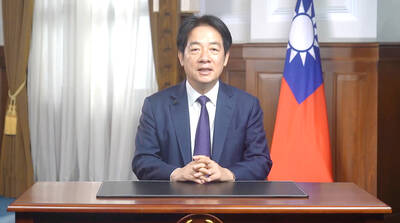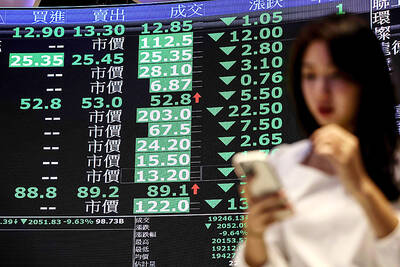A government document ordering schools’ procurement of teaching materials that mark Nanjing as the capital of the Republic of China (ROC) and Taipei as the current location of the central government indicated President Ma Ying-jeou’s (馬英九) administration’s persistent attempts to promote the links between Taiwan and China, as well as the administration’s misinterpretation of the Constitution, lawmakers and academics said yesterday.
A photograph posted by National Taipei University of Education professor Lee Hsiao-feng (李筱峰) on Facebook yesterday, which showed a Ministry of Education document issued on Monday to schools nationwide, went viral on the Internet.
“The document reflects the Ma administration’s ideology and its state of mind as a government-in-exile, which the majority of Taiwanese do not agree with. We should not be surprised because Ma has always tried to go against the trend,” Lee said.

Photo downloaded from Lee Hsiao-feng’s Facebook page
The professor said the photo was taken by one of his students, who is a teacher.
“Although Taiwan and mainland China have been marked with different colors in the textbook, Nanjing should be the ROC capital and Taipei is the current location of the central government, according to the ROC Constitution,” the document said.
Due to universal standards in map legends, Taipei would still be marked as the capital on the maps in teaching materials, but teachers are obligated to clearly explain the complexity of the situation to their students, the ministry said in the document, which was sent to high schools, vocational schools, junior-high schools and elementary schools across the country, except for those in Taipei, Greater Kaohsiung and New Taipei City (新北市).
Lee said that Ma has been trying to sinicize teaching materials, for example by insisting on referring to the period during which Taiwan was a Japanese colony as the “Japanese occupation period” in high-school textbooks.
Democratic Progressive Party (DPP) Legislator Lee Chun-yi (李俊俋) said the Constitution does not designate any city as the capital.
“Ma has been using the Constitution as a political tool to link Taiwan with China and to endorse his initiative of ‘one country, two regions.’ Everyone knows it’s nonsense and his interpretation of cross-strait relations is far from reality,” Lee Chun-yi said.
Under Ma’s leadership, government officials’ interpretation of the nation’s status has been “absurd,” he added, citing the example of Mongolian and Tibetan Commission Minister Tsai Yu-ling (蔡玉玲), who recently said that Mongolia remains ROC territory.
Ma has been inconsistent, DPP Legislator Chen Chi-mai (陳其邁) said, as he said he wanted to “make Taipei a world-class capital city” when he served as Taipei mayor.
The DPP administration between 2000 and 2008 reiterated that Taipei is the ROC capital, Chen said.
“Judging by a series of policy changes during the Ma administration, it has been engaging in a ‘de-Taiwanization campaign’ in an attempt to brainwash students and to force Ma’s ‘one China’ ideology upon young people,” Chen said.
Later yesterday, the ministry official in charge of the matter said he would take full administrative responsibility for not making the ministry’s intent clear in the document.
The head of the ministry’s K-12 Education Administration Division, Chiu Chien-kuo (邱乾國), said that during the Period of Political Tutelage (訓政時期), it had been mentioned that the capital of the nation was Nanjing, but there was no such mention in the Constitution after its ratification.
Since the implementation of the Act Governing Principles for Editing Geographical Educational Texts (地理教科書編審原則) in 1997, the guiding principle for all maps in geographical textbooks was that Taipei was to be marked as the capital with a label stating: “Location of Central Government,” Chiu said.
The part in the ministry’s document mentioning Nanjing did not provide a detailed explanation, for which he extended his apology, saying he was willing to assume responsibility for any administrative lapse, he added.
Additional reporting by staff writer

ACTION PLAN: Taiwan would expand procurement from the US and encourage more companies to invest in the US to deepen bilateral cooperation, Lai said The government would not impose reciprocal tariffs in retaliation against US levies, President William Lai (賴清德) said yesterday, as he announced five strategies to address the issue, including pledging to increase Taiwanese companies’ investments in the US. Lai has in the past few days met with administrative and national security officials, as well as representatives from various industries, to explore countermeasures after US President Donald Trump on Wednesday last week announced a 32 percent duty on Taiwanese imports. In a video released yesterday evening, Lai said that Taiwan would not retaliate against the US with higher tariffs and Taiwanese companies’ commitments to

Intelligence agents have recorded 510,000 instances of “controversial information” being spread online by the Chinese Communist Party (CCP) so far this year, the National Security Bureau (NSB) said in a report yesterday, as it warned of artificial intelligence (AI) being employed to generate destabilizing misinformation. The bureau submitted a written report to the Legislative Yuan in preparation for National Security Bureau Director-General Tsai Ming-yen’s (蔡明彥) appearance before the Foreign Affairs and National Defense Committee today. The CCP has been using cognitive warfare to divide Taiwanese society by commenting on controversial issues such as Taiwan Semiconductor Manufacturing Co’s (TSMC, 台積電) investments in the

HELPING HAND: The steering committee of the National Stabilization Fund is expected to hold a meeting to discuss how and when to utilize the fund to help buffer the sell-off The TAIEX plunged 2,065.87 points, or 9.7 percent, to close at 19,232.35 yesterday, the highest single-day percentage loss on record, as investors braced for US President Donald Trump’s tariffs after an extended holiday weekend. Amid the pessimistic atmosphere, 945 listed companies led by large-cap stocks — including Taiwan Semiconductor Manufacturing Co (TSMC, 台積電), Hon Hai Precision Industry Co (鴻海精密) and Largan Precision Co (大立光) — fell by the daily maximum of 10 percent at the close, Taiwan Stock Exchange data showed. The number of listed companies ending limit-down set a new record, the exchange said. The TAIEX plunged by daily maxiumu in just

‘COMPREHENSIVE PLAN’: Lin Chia-lung said that the government was ready to talk about a variety of issues, including investment in and purchases from the US The National Stabilization Fund (NSF) yesterday announced that it would step in to staunch stock market losses for the ninth time in the nation’s history. An NSF board meeting, originally scheduled for Monday next week, was moved to yesterday after stocks plummeted in the wake of US President Donald Trump’s announcement of 32 percent tariffs on Taiwan on Wednesday last week. Board members voted to support the stock market with the NT$500 billion (US$15.15 billion) fund, with injections of funds to begin as soon as today. The NSF in 2000 injected NT$120 billion to stabilize stocks, the most ever. The lowest amount it